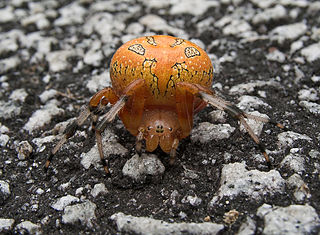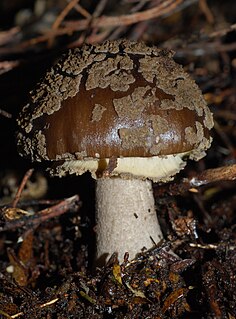
The red underwing is a moth of the family Erebidae. The species was first described by Carl Linnaeus in his 1767 12th edition of Systema Naturae.

Pirate spiders, members of the family Mimetidae, are araneomorph spiders which typically feed on other spiders.

The silver-ground carpet is a moth of the family Geometridae. The species was first described by Michael Denis and Ignaz Schiffermüller in 1775. It is common throughout the Palearctic region including the Near East and North Africa.It is found in a variety of different habitats and occurs, for example, in humid forests, moorland and shore areas, on embankments or on unimproved grass meadows and heathlands as well as in gardens.

The mottled umber is a moth of the family Geometridae. It is common throughout much of the Palearctic region. The species was first described by Carl Alexander Clerck in 1759.

Laothoe populi, the poplar hawk-moth, is a moth of the family Sphingidae. The species was first described by Carl Linnaeus in his 1758 10th edition of Systema Naturae. It is found throughout the Palearctic region and the Near East and is one of the most common members of the family in the region. It is distinctive due to its habit of resting with its hindwings held further forward than the forewings.

The square-spot rustic is a moth of the family Noctuidae. It is found in Europe, North Africa and east across the Palearctic and in North America.

The purple hairstreak is a butterfly in the family Lycaenidae distributed throughout much of Europe, North Africa, Anatolia, Caucasia, and Transcaucasia. The larva feeds on Quercus robur, Quercus petraea, Quercus cerris and Quercus ilex.

The silver-studded blue is a butterfly in the family Lycaenidae. It has bright blue wings rimmed in black with white edges and silver spots on its hindwings, lending it the name of the silver-studded blue. P. argus can be found across Europe and east across the Palearctic, but is most often studied in the United Kingdom in which the species has experienced a severe decline in population due to habitat loss and fragmentation.

The large tortoiseshell or blackleg tortoiseshell is a butterfly of the family Nymphalidae.

The heath fritillary is a butterfly of the family Nymphalidae. It is found throughout the Palaearctic from western Europe to Japan, in heathland, grassland, and in coppiced woodland. Its association with coppiced woodland earned it the name "woodman's follower" in parts of the UK. It is considered a threatened species in the UK and Germany, but not Europe-wide or globally.

The nutmeg, also known as the clover cutworm, is a moth of the family Noctuidae.

Cerapteryx graminis, the antler moth, is a moth of the family Noctuidae. It is a common species throughout most of Europe but is lacking in the very dry southern regions. The northernmost occurrence is Iceland, and above the Arctic circle. It also occurs in Siberia and in North Mongolia. The species has been introduced to North America. In the Alps it rises to an altitude of 2100 meters.

Baudin's black cockatoo, also known as Baudin's cockatoo or the long-billed black cockatoo, is a species of genus Zanda found in southwest Australia. The epithet commemorates the French explorer Nicolas Baudin. It has a short crest on the top of its head, and the plumage is mostly greyish black. It has prominent white cheek patches and a white tail band. The body feathers are edged with white giving a scalloped appearance. Adult males have a dark grey beak and pink eye-rings. Adult females have a bone coloured beak, grey eye-rings and ear patches that are paler than those of the males.
The gracile tateril or slender gerbil is a species of rodent found in Burkina Faso, Chad, Gambia, Ghana, Guinea, Ivory Coast, Mali, Niger, Nigeria, Senegal, Togo, and possibly Cameroon. Its natural habitats are dry savanna, arable land, pastureland, and rural gardens. It is a common species, sometimes considered an agricultural pest, and the International Union for Conservation of Nature has rated its conservation status as being of "least concern".

Araneus marmoreus, commonly called the marbled orbweaver, is a species of spider belonging to the family Araneidae. It is sometimes also called the pumpkin spider from the resemblance of the female's inflated abdomen to an orange pumpkin. It has a Holarctic distribution. Like other orbweavers, the marbled orbweaver is not considered a medically significant species.

Amanita nothofagi is a species of fungus in the family Amanitaceae. Endemic to New Zealand, the species was first described by mycologist Greta Stevenson in 1962. The fruit bodies have dark brown caps that are up to 13 cm (5.1 in) in diameter and covered with patches of soft greyish-brown scales or warts. The gills underneath the cap are crowded together, free from attachment to the stem, and white, becoming tinged with yellow in age. The stem of the mushroom is 4–14 cm (1.6–5.5 in) long by 0.5–2.5 cm (0.2–1.0 in) thick, and has a ring. The spore print is white, and individual spores are spherical to ellipsoid, measuring 7.5–9 by 7.5–9 micrometres. The mushroom may be confused with another New Zealand species, A. australis, but can be distinguished by certain characteristics. Amanita nothofagi is a mycorrhizal species, and grows in association with native New Zealand trees such as Southern Beech.

Tetragnatha extensa is a species of spider found across the Northern Hemisphere. It has an elongate body, up to 11 mm (0.43 in) long, and adopts a straight line posture when alarmed. It lives on low vegetation in damp areas, and feeds on flying insects which it catches in its web.

Arkys lancearius, the triangular spider, is a common Australian spider belonging to the family Arkyidae. It is an ambush hunter, commonly found resting on leaves and ferns or hanging from just a few threads of silk. The front two pairs of legs are large, suited for grabbing small insects, while the rear pairs of legs are much smaller.

Ero is a genus of pirate spiders first described in 1836. They resemble comb-footed spiders due to their globular abdomen, which is higher than it is long.

















